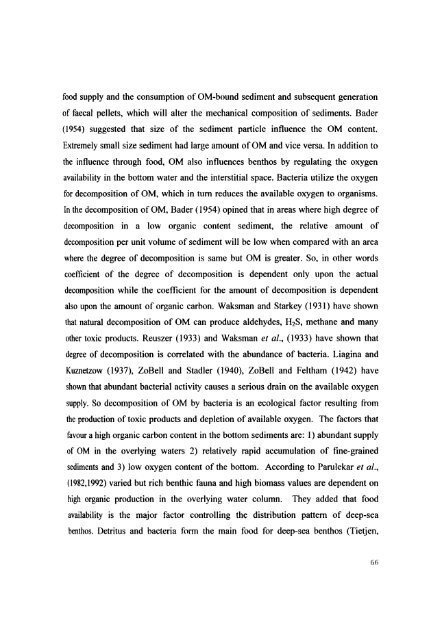L - Cochin University of Science and Technology
L - Cochin University of Science and Technology
L - Cochin University of Science and Technology
Create successful ePaper yourself
Turn your PDF publications into a flip-book with our unique Google optimized e-Paper software.
food supply <strong>and</strong> the consumption <strong>of</strong> OM-bound sediment <strong>and</strong> subsequent generation<br />
<strong>of</strong> faecal pellets, which will alter the mechanical composition <strong>of</strong> sediments. Bader<br />
(1954) suggested that size <strong>of</strong> the sediment particle influence the OM content.<br />
Extremely small size sediment had large amount <strong>of</strong> OM <strong>and</strong> vice versa. In addition to<br />
the influence through food, OM also influences benthos by regulating the oxygen<br />
availability in the bottom water <strong>and</strong> the interstitial space. Bacteria utilize the oxygen<br />
for decomposition <strong>of</strong> OM, which in turn reduces the available oxygen to organisms.<br />
In the decomposition <strong>of</strong> OM, Bader (1954) opined that in areas where high degree <strong>of</strong><br />
decomposition in a low organic content sediment, the relative amount <strong>of</strong><br />
decomposition per unit volume <strong>of</strong> sediment will be low when compared with an area<br />
where the degree <strong>of</strong> decomposition is same but OM is greater. So, in other words<br />
coefficient <strong>of</strong> the degree <strong>of</strong> decomposition is dependent only upon the actual<br />
decomposition while the coefficient for the amount <strong>of</strong> decomposition is dependent<br />
also upon the amount <strong>of</strong> organic carbon. Waksman <strong>and</strong> Starkey (193 I) have shown<br />
that natural decomposition <strong>of</strong> OM can produce aldehydes, H2S, methane <strong>and</strong> many<br />
other toxic products. Reuszer (1933) <strong>and</strong> Waksman et al., (1933) have shown that<br />
degree <strong>of</strong> decomposition is correlated with the abundance <strong>of</strong> bacteria. Liagina <strong>and</strong><br />
Kuznetzow (1937), ZoBell <strong>and</strong> Stadler (1940), ZoBell <strong>and</strong> Feltham (1942) have<br />
shown that abundant bacterial activity causes a serious drain on the available oxygen<br />
supply. So decomposition <strong>of</strong> OM by bacteria is an ecological factor resulting from<br />
the production <strong>of</strong> toxic products <strong>and</strong> depletion <strong>of</strong> available oxygen. The factors that<br />
favour a high organic carbon content in the bottom sediments are: I) abundant supply<br />
<strong>of</strong> OM in the overlying waters 2) relatively rapid accumulation <strong>of</strong> fine-grained<br />
sediments <strong>and</strong> 3) low oxygen content <strong>of</strong> the bottom. According to Parulekar et al.,<br />
(1982,1992) varied but rich benthic fauna <strong>and</strong> high biomass values are dependent on<br />
high organic production in the overlying water column. They added that food<br />
availability is the major factor controlling the distribution pattern <strong>of</strong> deep-sea<br />
benthos. Detritus <strong>and</strong> bacteria fonn the main food for deep-sea benthos (Tietjen,<br />
66

















